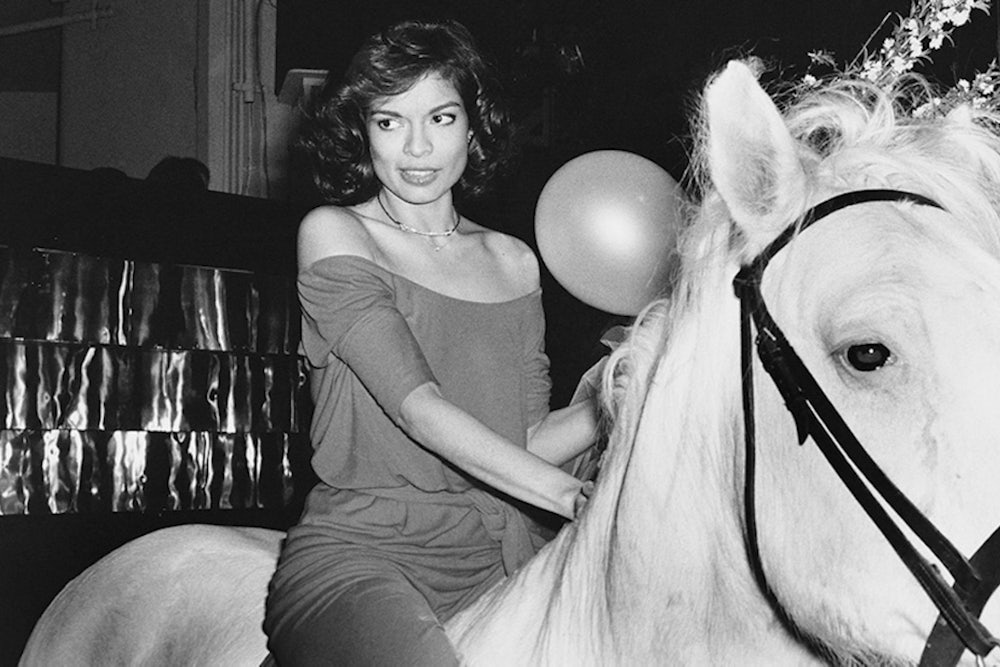Last year, the Brooklyn Museum hosted Frida Kahlo: Appearances Can Be Deceiving, an exhibition that displayed the artist’s clothing and cosmetics and some other ephemera alongside a handful of her paintings. It was installed in a tight maze of rooms that reminded me of the marketplace you have to wander through to get out of IKEA, and though photographs were forbidden it was much-Instagrammed.
It’s grim to catch yourself muttering But is it art?—to realize that you’re the curmudgeon. Of course it’s not art! Museums increasingly rely on spectacle to goose their attendance and, presumably, gift shop revenue. Maybe it is elitist to think that museums should focus on Jacques-Louis David and not, say, David Bowie. The Brooklyn Museum currently has a show on the former; it will not break attendance records as their 2018 show on the latter did.
Matthew Yokobosky, the curator who organized David Bowie is, has now created Studio 54: Night Magic, an inquiry into the midtown Manhattan nightclub that opened in 1977 and closed three years later but still serves, 40-plus years on, as a metonym for glamour, decadence, drugs, celebrity. It’s a study of material culture, fashion design, photography, music, and video. As I wandered through the show, I couldn’t even mutter But is it art? because there’s disco playing—insipid, impenetrable, somehow perfect—and I couldn’t think straight. I hope the museum guards are receiving hazard pay.
The show overexplains, anticipating your skepticism. It reminds us that the World Trade Center opened in 1973, a glimmer of optimism, a vision of the future, though the city was falling apart. It argues that Studio 54 was an expression of that thinking, the people of New York—black, white, gay, straight, rich, poor—getting together to have a little fun. It is an incredible show to see at this particular moment in time, but, of course, you cannot see it, as the Brooklyn Museum is closed for the nonce.
The New York on display here has never felt more distant. Orgiastic mingling instead of social distancing! Near-ruins instead of luxury condos! This pandemic-panicked moment is especially weird, but haven’t we already mostly given up on Jane Jacobs’s vision of urban life as a dynamic mix of forces? I was born the year Studio 54 opened, so I cannot feel any nostalgia about it. Instead, I just felt mournful for the sort of New York I’ll never know, one of possibility and joy instead of lots of empty branches of Chase Bank.
So what do we have here? There’s some barware from the museum’s collection, some archival photographs of New York City. There’s video, which has an especially strange effect because it dates from a pre–Instagram Stories era, lingering for what feels like an eternity, like Andy Warhol shot it. Actually he did shoot some of it, prehistoric footage of Liza Minnelli and John Lennon hanging at the Studio. It made me feel so horribly sad.
The whole show is an act of mourning. Here’s an acne-scarred and recognizably black Michael Jackson, gushing about the freedom of dancing for fun instead of for work. Here are dozens of anonymous revelers who probably died of AIDS. Here are architectural drawings of the space, an old theater, and photographs of the staff, beautiful boys in disarmingly sexy shorts. Here’s the guest list from the opening night, and the drink tickets, and sketches and clothes by the designers of the era. There are photos and video of Grace Jones, surely one of the most beautiful human beings ever to live. She’s a work of art.
The exhibition is fun, and it’s thoughtful enough but doesn’t push you too hard to think. You can ask whether it’s malpractice to legitimize proto-paparazzo Ron Galella by hanging his snapshots on a museum wall. You can marvel at the craft of a custom Halston ensemble, though really you just end up noting that Liza Minnelli, a larger-than-life figure, is so damn tiny. You can swoon at the deranged beauty of Jerry Hall, modeling Stephen Burrows at Studio 54 the very night she first met Mick Jagger, then pause to appreciate how Hall has pulled off the greatest last laugh in history by marrying Rupert Murdoch.
Mostly, you just shuffle from room to room, going increasingly mad as the music continues to blare. You can dance the night away, but the sun still rises. The club closed after less than three years. Terribly fitting, somehow, the fate of the club’s founders: Steve Rubell, closeted during his life, died of complications from AIDS; Ian Schraeger continued his strategy of urban renewal by inventing the boutique hotel.
It is so apt that the major sponsor of Studio 54: Night Magic is Spotify. This moment of quarantine will, one hopes, pass, but we’ve largely abandoned a society that values communion for one dictated by the algorithm. You cannot, for the time being, attend this exhibition, but you can stay home and listen to disco on a loop. The show argues that the cocktail of drugs, dance, and glamour had an effect on the way we lived then and now: Fashion, music, and industrial design continue to be inspired by that chapter of American life. This is what Jane Jacobs told us: Culture is born of interaction. What will isolation—whether mandated by fear of illness, or just the logical outcome of technology—yield?
